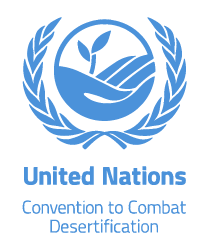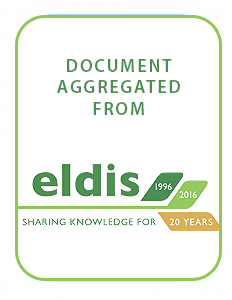Location
The United Nations Convention to Combat Desertification in Those Countries Experiencing Serious Drought and/or Desertification, Particularly in Africa (UNCCD) is a Convention to combat desertification and mitigate the effects of drought through national action programs that incorporate long-term strategies supported by international cooperation and partnership arrangements.
Members:
Resources
Displaying 571 - 575 of 586United Nations Convention to Combat Desertification in Countries Experiencing Serious Drought and/or Desertification, Particularly in Africa: full text of Convention
Full text of the Convention to Combat Desertification, which was elaborated by the Intergovernmental Negotiating Committee (INCD) and signed in June 1994.Also available from the CCD WWW site in French and English
Promotion of Sustainable Food Systems in India through Transforming Rice-Wheat Systems in Punjab, Haryana, Odi
Objectives
To promote sustainable, integrated landscapes and efficient food value and supply chains at scale in rice- and wheat-based food systems in India.
Other
Note: Disbursement data provided is cumulative and covers disbursement made by the project Agency.
Target Groups
1. Under the project model, the delivery of improved global environmental benefits (in terms of biodiversity, climate change mitigation and sustainable land management) will be inextricably accompanied by socioeconomic co-benefits including the following: - Improved farmer incomes: in line with the target of the National Agricultural Development Plan (RKVY) to increase farmers’ incomes by 4% between 2016 and 2023, the project will improve farmers’ access to favourable markets for their products by: strengthening value chain linkages (through the Green Value Chain Development Cell, Output 2.2.1); enhancing their capacities for compliance with environmental sustainability criteria, such as those set out in the SRP Standard and third-party certification schemes (Output 2.2.3); and supporting complementary income generation options under Output 3.1.3. - Improved resilience to the volatility in economic and food systems at regional and global levels: the kinds of diversified production systems that are required to optimize GEBs also typically contribute to the resilience of farm families’ food security and livelihoods; - Improved resilience to the effects of climate change: diversified production systems capable of yielding GEBs are also typically climate-resilient, given that they contain a wide range of alternative crops and varieties and tend to foster stable micro-climates capable of buffering variations in temperature and humidity. - Improved nutritional quality: sustainable diversification away from high-yielding varieties (HYV) of rice and wheat to, for example, traditional varieties of rice, as well as other crops including vegetables, pulses and millets, will increase the availability of nutritious food both among the farmers themselves and among downstream consumers. As a co-benefit of the project, this will help to address the problems of overnutrition (and its associated health impacts including obesity and diabetes), undernutrition and anemia, which affect a significant proportion of the country’s population.
Inclusive Conservation Initiative
Objectives
Enhance Indigenous Peoples’ and Local Communities’ (IPLCs) efforts to steward land, waters and natural resources to deliver global environmental benefits.
Other
Note: Disbursement data provided is cumulative and covers disbursement made by the project Agency.
Target Groups
Improved management of forest, grasslands and marine ecosystems will generate a range of socio-economic benefits including contributions to enhanced food security and livelihoods across the set of ICI subprojects. Habitat conservation will also contribute to maintenance of key environmental provisioning services for a range of non-timber forest products (NTFPs) and other nature-based products. ICI grants will support activities that unlock or generate the financial resources IPLCs need to sustain their livelihoods and roles as environmental stewards. Depending on the particular subproject, this may include income-generating sustainable production activities (e.g. niche natural food products, improved livestock management, ecotourism) or innovative and culturally appropriate financing mechanisms such as IPLC trust funds and payments for ecosystem services. Several suproject EOIs indicated interest in developing community funds and other benefit-sharing mechanisms, as well as savings and credit groups. Other illustrative measures include targeted assistance to small and medium IPLC enterprises for enterprise development and to connect owners to mainstream financing. Activities will include a focus on women’s economic empowerment, and be oriented to benefit IPLC women and men through long-term approaches that enable self-determined land and resource governance and help reduce dependence on external donor support. A crucial aspect of socioeconomic benefits under the ICI will be cultural benefits. Several subproject EOIs indicated interest in recording and disseminating traditional knowledge, ranging from resource management practices to food production to customary rites. Documenting customary land use and land rights, as well as efforts focused on language preservation also reflect important cultural benefits. Some subprojects may consider mapping sites of current and archaeological cultural significance, as an input into designing suitable management arrangements. Finally, intergenerational cultural benefits are anticipated from efforts to disseminate traditional skills and knowledge (e.g. medicines, handicrafts, rites and language) to youth. Detailed plans, metrics, targets and M&E provisions with respect to cultural benefits will be elaborated in each subproject Impact Strategy. Specific on-the-ground activities to generate socioeconomic benefits will be determined during the first phase of implementation, through the preparation of Impact Strategies for each subproject (Output 1.1.2). Although the final sets of activities and their details cannot be determined before inclusive participatory planning processes are complete (including feasibility assessment, value chain analysis, etc.), the EOIs submitted by the selected subprojects anticipate the following indicative types of activities and benefits (see ProDoc Appendix X for a complete listing): Annapurna Conservation Area · Develop IPLC-based green enterprises · Promote Payments for Ecosystem Services · Identify diversified financial mechanisms, benefit-sharing mechanism on ACA revenues established and economic measures implemented to enhance economic resilience of IPLCs. DR Congo · Mapping of traditional areas of IPLCs · Reinforce legal status of IPLC claims to traditional territories · Develop strategies to strengthen socioeconomic resilience · Income generating activities based on sustainable management of biodiversity (e.g. NTFPs, artisanal products, agriculture, local tourism) Ewaso Ng’iro River Basin · Support legal recognition for community land and registering community conservancies · Develop management plan for pastoralist community governance of land and resources, including community benefits. · Create a Knowledge Centre to ensure intergenerational flow of knowledge and share knowledge with other stakeholders Futa Mawiza Biocultural Territory · Elaborate community plans and projects to protect territory · Investment in projects prioritized by each community (e.g. tourism, ecological production, food sovereignty, inventory and safeguarding of seeds) · Implement projects to strengthen conservation of the Futa Mawiza territory (e.g. tourism network, exchange networks) Lau Seascape and Cook Islands · Document cultural knowledge and heritage of IPLC · Develop toolkit to support islanders in applying traditional food production practices · Strengthen financial and project management capacity of IPLCs Northern Tanzania · Train and coach village councils and CBO’s in management and use of community funds generated by carbon offset sales · Train and coach savings and credit groups targeting women and youth · Develop sustainable natural resource-based income generating activities (e.g., beekeeping, traditional medicine, livestock fattening) Ru K'ux Abya Yala · Develop indigenous territorial management plans · Market added value products from indigenous enterprises · Strengthen technical and administrative capacity in community enterprises Southern Amazon · Documentation, mapping and demarcation of ancestral lands · Document and promote traditional knowledge and practices to ensure food sovereignty, climate change mitigation, and biodiversity loss · Invest in sustainable community livelihoods Thailand · Prepare land-use maps based on traditional customs/knowledge, and support sound practices for resource, water, forest and fire management, as well as food security · Promote sustainable nature-based livelihoods (e.g. bee keeping, eco-tourism, handicrafts and animal raising)
Independent Evaluation of Ethiopia's Land Investment Transformation Programme
General
To support the Government of Ethiopia in the provision of map based land certificates to farmers in four regions and assist them to fully benefit from increased investment and productivity through the development of the rural land market and its supporting operations. The project will be a driver to increasing income by 20% for over 500,000 households. It will also secure land ownership for 6.1 million households, of whom around 70% will be women
Gender and access to land
Gender issues are often ignored in projects that aim to improve land tenure and land administration. To support land administrators in governments and their counterparts in civil society, this guide shows where and why gender inclusion is important in projects. In order to help inform policy and implementation decisions, it identifies indicators for measuring the quality and quantity of access to land before, during and after an intervention and outlines recommended principles for gender inclusion in land administration projects.




